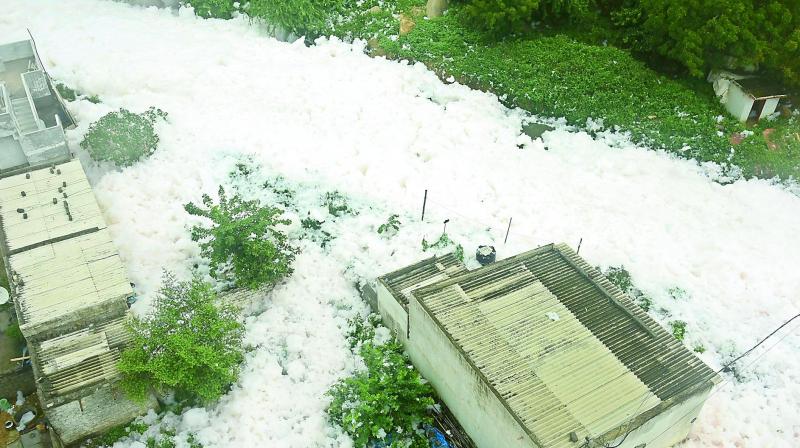Hyderabad: Toxic foam engulfs Dharani Nagar

Hyderabad: An emergency situation prevailed at Kukatpally’s Dharani Nagar on Friday night as toxic froth overflew from the canal of Parkhi Cheruvu. It affected 50 houses, which are located beside the channel, spanning 1 km. They were covered with 10 feet high toxic foam till morning. The locals manually removed the foam.
“We left our home and took shelter at the Ganesh Chaturthi Pandal,” said B Khajamma, whose house was filled with toxic foam. This is the third incident this year and is causing health problems.
Officials from the Pollution Control Board came in the noon, and sprayed anti-foaming solution over the lake to quell it. However, within one hour the foam came back in full vigour.
“I have asked for the anti-foaming solution to use it in case of an emergency at night,” said a resident.
The residents allege that toxic waste from Jeedimetla has found its way into the lake and has caused foaming. However, the PCB has maintained that the foaming in Dharani nagar is not due to chemicals but because of sewage.
Bacteria behind frothing, says PCB
The Pollution Control Board has now stated that filamentous bacteria is causing the frothing and not detergents as claimed before.
This report comes after three months of intermittent lake frothing in various parts of the city evoked no substantial action from of PCB or the municipality.
Experts said that filamentous bacteria are small with a million tail-like phalanges attached on their bodies that move rapidly in water, causing the lake to froth up quickly and continuously.
The report stated that bacteria level in Neknampur village’s Pedda Ibrahim Cheruvu, RK Puram Lake and Nalla Cheruvu is alarmingly high.
“When there is less oxygen in the lake due to sewage and waste, these bacteria activate themselves and multiply,” said Dr Subba Rao, who found a similar issue in Bellandur Lake.
These bacteria originate not only from sewage but also from petro chemical industries and oil-based units.
The action plan mooted by experts, who are working on Bellandur Lake, is yet to be acted upon.
The action plan has asked to stop the mixing of sewage and storm water as it would contaminate all water bodies in the catchment area.
The report submitted by Dr Subba Rao also noted that that sewage treatment may not help reduce foaming as the bacteria are also found in treated waste water at Durgam Cheruvu.

